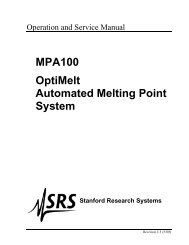Quartz Crystal Microbalance Theory and Calibration - Stanford ...
Quartz Crystal Microbalance Theory and Calibration - Stanford ...
Quartz Crystal Microbalance Theory and Calibration - Stanford ...
You also want an ePaper? Increase the reach of your titles
YUMPU automatically turns print PDFs into web optimized ePapers that Google loves.
www.thinkSRS.com<br />
excellent tool for the evaluation of fluid properties. Application examples include<br />
in situ monitoring of lubricant <strong>and</strong> petroleum properties 20 . The tight<br />
correspondence between theory (equations 6 & 7) <strong>and</strong> experiment is clearly<br />
illustrated by Figure 7.<br />
Dissipation Technique<br />
An alternative method 21 for studying the properties of the loaded QCM Sensor,<br />
called the “Dissipation Technique” has been used in gaseous as well as in liquid<br />
environments. In this case, the crystal is driven at its resonant frequency by an<br />
oscillator that can be intermittently disconnected causing the crystal oscillation<br />
amplitude to decay exponentially. From the recorded decay curve the absolute<br />
Q-factor (inversely proportional to R) <strong>and</strong> the frequency of the oscillator are<br />
simultaneously obtained. Independent studies 22 have shown that as long as the<br />
effect of the parasitic capacitance (C 0 ) is properly cancelled, the results provided<br />
by the Dissipation Technique should be in good agreement with the<br />
measurements provided by the QCM100 System.<br />
Temperature<br />
The intrinsic dependence of the resonant frequency of a quartz crystal on<br />
temperature is well known <strong>and</strong> generally quite small. In fact, the AT-cut quartz<br />
crystal commonly used in QCM experiments owe their popularity to their near<br />
zero coefficient at room temperature. As a result, the intrinsic temperature<br />
dependence of the QCM sensor crystals is negligible at or around room<br />
temperature (≈ 1-3 Hz/°C) <strong>and</strong> is generally ignored for monolayer<br />
adsorption/desorption processes in the gas phase.<br />
Much larger changes in frequency with temperature are observed when QCM<br />
crystals are immersed in liquids. This is due to the coupling of the shear mode<br />
oscillation with the temperature dependent viscosity <strong>and</strong> density of the fluid- the<br />
temperature coefficient due to this effect is ≈ 8Hz/ ºC for water. As a result, for<br />
experiments in liquid phase in which the frequency is to be monitored at length,<br />
the temperature must be controlled to at least 0.1°C, <strong>and</strong> preferably better. In<br />
electrochemical experiments this is often achieved with temperature controlled<br />
baths <strong>and</strong> jacketed cells. If temperature control is not possible or practical, it is<br />
always good practice to wait at least 30 minutes before performing any accurate<br />
measurements after the crystal comes in contact with a new medium <strong>and</strong><br />
measure the temperature of the solution around the crystal during the<br />
experiments to perform temperature compensation. It is also common practice to<br />
soak the mounted crystal(s) in the solution overnight before performing any<br />
experiments to assure more stable readings.<br />
Careful control of the temperature is required in high accuracy measurements to<br />
avoid frequency hysterisis effects- the dependence of resonator frequency at a<br />
<strong>Stanford</strong> Research Systems (408)744-9040

















